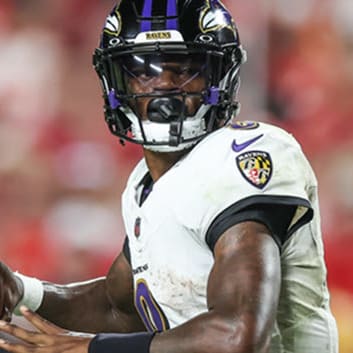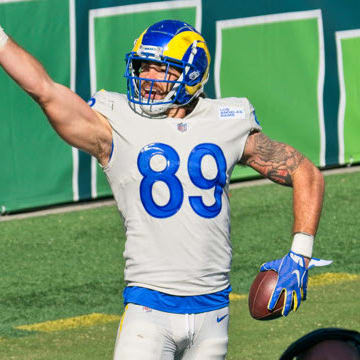This article is part of our Dynasty Strategy series.
Rashaad Penny is one of the most criticized first-round picks of the past decade or so. His critics expressed repulsion for a number of reasons – The Seahawks took him over Nick Chubb! – They already had Chris Carson! – Running backs aren't worth it anyway! – Penny isn't even good!
The first two points are reasonable enough. Penny is not as good as Chubb and the Seahawks had bigger needs than running back, especially if they were just going to commit to Carson anyway. The third point is at best debatable. The fourth is not true.
Whatever someone thinks about Penny as a first-round pick should be separated from the question of whether Penny is a talented player. The question of whether Penny is talented was never in any reasonable doubt. Injuries and arguably work ethic concerns apply – Penny was accused of showing up to the Seahawks overweight, and his durability history in the NFL is not encouraging – but few players in the league are as dangerous as Penny when he has the ball. As much as his injury history highlights the risk involved with Penny as he heads into free agency, it would be an unserious assessment of Penny to deny that he also has unique upside, both in fantasy football and for whatever team he plays for in 2022.
INTEL
College Production
It's one thing to worry about Penny's durability – doubtlessly a reasonable concern. It's another thing to suggest that Penny ever lacked talent or productivity. Penny was one of the best running backs in college football history at San Diego State, and the best running back out of that school since Marshall Faulk. The player we saw in 2021 looked eerily similar to the one you would have seen in the Aztecs backfield from 2014 to 2017.
Penny was a backup his first two years while accomplished upperclassmen Donnel Pumphrey and Chase Price handled the prolific San Diego State backfield, but even then Penny was flashing his unmistakable big-play ability, returning three kickoffs for touchdowns on 44 attempts (29.6 YPR) over those two years. The playing time finally picked up for Penny in his junior season, though Pumphrey was still present and ran for over 2,000 yards that year. Even with Pumphrey running for 2,133 yards (6.1 YPC) and 17 touchdowns, Penny ran for 1,018 yards and 11 touchdowns of his own, at a mammoth 7.5 yards per carry. He added 15 receptions for 224 yards and three touchdowns on just 20 targets and returned two more kickoffs for touchdowns on just 20 attempts (31.2 YPR).
At long last, Pumphrey headed to the NFL following Penny's junior year, finally clearing the way for Penny to take the workhorse role. What happened next was one of the most impressive seasons in college football history. Penny went completely nuts, generating 2,248 yards and 23 touchdowns while averaging a preposterous 7.8 yards per carry. To produce that level of efficiency on that workload volume is point blank proof in itself of Penny's rare ability as a runner. We knew at this moment (if not sooner) that Penny is a truly unique danger with the football. He also ran for another two kickoff return touchdowns, giving him a career average of 30.2 yards per return and seven touchdowns on just 81 attempts. Absurd!
Athleticism
Penny's San Diego State career made clear that he knows how to run away from people. The combine confirmed that, in addition to the skill Penny possessed as a runner, he had the athletic tools to manifest those skills at the NFL level. Some players have the skill but lack the tools to dominate in the NFL the way they did in college. Think of Darrell Henderson, winning almost strictly with speed at the college level but only running a 4.49 40-yard dash at 208 pounds. Henderson is a fine enough NFL player, but he's clearly not what he was at Memphis in college.
By contrast, Penny's 4.46-second 40 on a 220-pound frame was confirmation that Penny's college tricks should translate to the pro level. According to Mockdraftable.com, Penny's 220 pounds ranks in the 57th percentile among running backs, yet his 4.46 ranks in the 86th percentile. Penny is both bigger than most NFL running backs yet much faster than most NFL running backs. He won with speed in college, and a 4.46 at 220 pounds means he can keep winning with speed at the NFL level. Though it wouldn't occur until a frustrating four years later, Penny's 2021 NFL season was another data point confirming the prior indications of Penny's collegiate production and athletic metrics.
NFL Production
Aside from a three-game span in 2020 (34 yards on 11 carries) where he attempted to return from a knee injury that swiftly ended his season again, Penny has only been productive in his four NFL seasons. He nonetheless drew substantial criticism for failing to draw playing time over Carson, a seventh-round pick from the draft before Penny. Penny's public reception probably hit a new low around the mid point of the 2021 season, when he returned from a calf injury suffered in Week 1 and played behind Alex Collins for six weeks. Collins is not very good, of course, so if Penny's playing time in that span were a measure of his merit then he would grade lowly indeed. Given what happened next, though, it seems safe to say in hindsight that Penny played behind Collins for either an injury reason (Penny nearly went on IR with a hamstring injury about a month after returning from the calf injury in Week 7) or for no good reason.
Beginning with their Week 13 game against San Francisco, Penny finally saw his first chance at voluminous playing time. In more than three and a half seasons, this was the first time Penny was both healthy and allowed the chance to take over the Seattle backfield. What happened next isn't something you see often.
In the next six games Penny ran for 706 yards and six touchdowns on 102 carries, good for 6.9 yards per carry. Granted, Penny had room to work with as a runner, especially against the relatively weak run defenses of Houston, Detroit, Chicago and Arizona, but (A) Penny produced better against those teams than other running backs did and (B) two of the six games were against two of the league's toughest run defenses with San Francisco and the Rams. Perhaps there is regression waiting for Penny, but the schedule sample is fairly representative of a realistic schedule. Penny ran for a combined 74 yards on 21 carries against the Rams and 49ers, and his rushing average of 3.5 yards per carry mostly lines up with what those defenses combined to allow to running backs (3.6 YPC) over the course of the year.
2022 PROJECTION
As you might have picked up on by now, this article takes the view that Penny's talent is completely beyond question. If there is cause to doubt Penny's abilities then there is cause to doubt any NFL running back's talent. The indicators that single out Penny as a plus talent are the same that singled out Nick Chubb and Jonathan Taylor. The basic point is that big, fast guys who run farther and faster than everyone else in college tend to work out in the NFL. Not everything needs to be complicated.
Unfortunately in Penny's case, despite the overwhelming evidence of his standout talent, there's also an uncommon level of injury concern. Penny also showed up to the Seahawks overweight as a rookie, and lax work habits tend to bring out the worst injury results. If Penny is prone to injury in the first place, then it's exacerbated by the likely fact that Penny isn't quite as devoted to his job as players like Chubb and Taylor, who are by all accounts freakishly obsessive about their work. Penny might fall more so into the category of an extremely talented player who views the game as work rather than a passion. It's something to keep in mind.
Whatever the specific reasons, Penny has struggled with injuries in the NFL. He hasn't played a full season yet, his 14 games as a rookie the highest game total he could muster. He played 10 games in 2019 before suffering a season-ending knee injury, an injury that should have kept him out the entire 2020 as well despite a feeble attempt to return in the final three games before suffering reinjury. Then in even this breakout 2021 season Penny missed time with calf and hamstring issues.
So while this article takes the view that only the uninformed would question Penny's abilities, it also concedes that Penny's utility carries more conditions than with other, similarly talented players. Indeed, for as much as Penny's upside is beyond dispute, the same can be said of the risk he carries as he enters unrestricted free agency.
Penny turns 26 tomorrow, Feb. 2. His workload the past four years has been light, especially for a player of his pedigree and collegiate production. It's easy to imagine a timeline where, blessed with new luck for whatever reason, Penny goes on to fully harness his abilities and rakes for the indefinite future, be it in Seattle or elsewhere. There's also a timeline where the same injury issues that plagued the first four years hound him for the indefinite remaining future. This article has no means of guessing which scenario is more likely.
To invest in Penny is to play with fire, in all of the classic good and bad senses. Fire can burn a person or otherwise behave destructively. Fire can also serve as a life-changing source of energy. The question of which Penny you get seems left to the mercy of chance. A helpful comparison might be Fred Taylor. Like Penny, Taylor was a size/speed standout with a wealth of memorable highlights. Also like Penny, Taylor dealt with cruel injury luck that held him back despite an otherwise impressive career. Perhaps there's an alternate dimension someplace, where Taylor's injury luck was more cooperative and he matched stride with the LaDainian Tomlinsons of the league. Perhaps there's another dimension where Taylor had worse luck yet.
As Penny heads into free agency the possibilities seem limitless. The Seahawks still have Chris Carson under contract for one year, though his own injury history might lead Seattle to commit to Penny instead. If the Seahawks decline to commit to Penny then some other team with a bit of spare change might take up the opportunity. Guessing which team that might be or the general market reception Penny might receive just doesn't seem possible with what we know now, which isn't much. But in the meantime the possibility for the best-case scenario persists, and if it occurs it could cause a pain in the neck of those who fade Penny.












